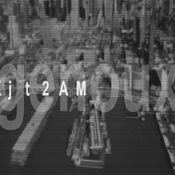 |
|
 |
 |
 |
 |
 |
  |
webwork 2
LA RÉVOLUTION À NEW-YORK A EU LIEU,
by Gregory CHATONSKY, 2003
 Implosion Recollected
Implosion Recollected
Chris Marker's La Jetée - The Jetty - came out more than 40 years ago, in 1962. A spellbinding work put together of black and white photographs and strung with twists - a man, as a child, witnesses his own death as an adult -, The Jetty relentlessly questioned the reality of memory and afforded a restless, melancholic look on a world that seemed to gradually escape human understanding.
Why mention this film? Because Gregory Chatonsky's very beautiful La révolution à New York a eu lieu resonates on our world as The Jetty once did.
Chatonsky, like Marker, invokes memory, a strange, inhuman memory sculpted with images and words. But while Marker drew from the vectors of time - past, present, and future -, Chatonsky's work emerges from the strange, half-human, half-machine clay of the Web. For Chatonsky, as for Marker before him, memory is gathered into an elsewhere created of machines, murmurs, and perceptiveness; it reaches beyond the individual and out-distances matter, flesh, and face. Without one's own memory, say Chatonsky and Marker, one is only an evanescent form, withering easily in the disorderly world, the temporary and mortal receptacle of civilization's imprint, a shadow in search of coherence and unity. In a world of machine reminiscences, the individual is a collection of fragments in constant implosion.
Implosion: like the collapse of the Twin Towers that Chatonsky explicitly alludes to; like the Net surfer's mind furrowed by the ebb and flow of images, words, realities, calamities, and fictions in this Web work.
Chatonsky's narrative material is that substance peculiar to the new millennium, where machines surf on the ocean of our representations and send us back echoes of time, shards of truth. We think ourselves up with those echoes, we make ourselves with the shards.
Chatonsky erects a work on network memory and algorithmic recollections. He tells us we now belong to a world whose order is beyond the organic, whose essence is beyond the human, a universe whose existence emerges as we make our way into it. While Marker, in The Jetty, managed to crystallize the anxiety of his day, Chatonsky wholly succeeds in tracing the breakup of his own, its characteristic fascination for elsewhere.
There, in fact, is the very essence of hypertextual narration: to suggest avenues that throw the "reader" off-center, propel him or her toward far-off places filled with hopes and promises. One does not read hypertext, just as one does not read the febrile state of daily life. Instead, one must let oneself be carried by its current, feel its strength, listen to its music, bathe in its words. Hypertext is not a book, narration, or linear account. It is a free fall into emptiness, a trip through weightlessness, plunged into entanglements (of men and machines, fictions and realities, violence and pleasure, memories and simulations). A hypertextual work that encompasses this reflects on the world that gave birth to it. That is Chatonsky's achievement: his work is not a story, but resonances.
Marker's character drifted on the currents of memory where he contemplated reality's shadows. Chatonsky's barely copes with the tempests of a new real, reflective mosaics in the swells of the network.
Ollivier Dyens

 top top
 back back
|
|
 |
 |
 |
|

